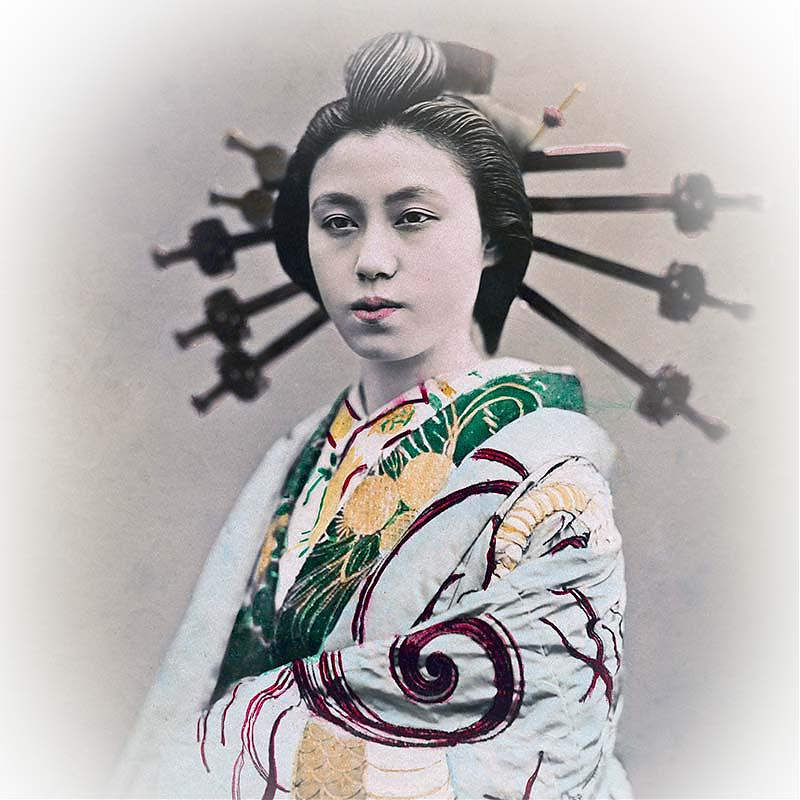Two Ainu women using a traditional Ainu mortar (nisu), made from a hollowed-out sugi (cryptomeria) log. It was used for threshing millet (later replaced by rice), wheat, and roots, as well as for beating grains into flour and paste.
The two-ended pestle (iyutani) was held in the middle, which was slightly thinner. Although photographs usually show the women holding the pestle with a single hand, English painter, explorer, writer and anthropologist Arnold Henry Savage Landor (1865–1924), who visited the Ainu during an exploration in the late 19th century, describes both hands being used1:
During the process of pounding millet—which is only practised in the southern part of Yezo [Hokkaido]—two or three girls stand round a mortar in which the millet has been placed, and each girl, holding with both hands a pestle, beats and sings, one after the other, the words “Huye, huye,“ as the pestle is let down, increasing in loudness when the grain requires harder pounding, and slowly decreasing in volume towards the end. This pounding begins about sunset, and the place chosen for the operation is generally the small porch of the huts. It has indeed a weird effect to hear these many voices from the distant huts gradually dying away as darkness comes on, till finally only two or three break the stillness of the coming night. Then even those wear away, and everything becomes as silent as the grave.
Although agriculture played a role in Ainu society, it was a secondary one, supplementing the main diet of fish (especially salmon and trout), game and a wide variety of wild plants. Game consisted mainly of deer, bear, rabbit, fox, and raccoon dog. But other animals like birds were also part of the Ainu menu.
Food was dried in the sun, boiled and dried, or smoked on racks above a fireplace. The exception was trout, which was grilled before being dried. In order to survive the long hard winters of the Ainu territories, food was stored in elevated storehouses called pu.
Ainu usually ate two meals a day, breakfast and dinner. Lunch was eaten only occasionally. The staple food consisted of a type of soup (ohaw or rur), which could contain meat, fish or vegetables, with a sort of porridge (sayo) as side dish. Fish was also eaten on skewers. Additionally, grains, plants and vegetables were eaten. Fruit, and many wild plants, were eaten raw.
Seasoning consisted of fish or animal fat, salt and other spices. The main Japanese condiments of miso (soy bean paste) and shoyu (soy sauce) were not used.
Interestingly, chopsticks were only used by men. Women used wooden spoons.
Notes
1 Landor, Arnold Henry Savage (2001). Alone with the Hairy Ainu or, 3,800 Miles on a Pack Saddle in Yezo and a Cruise to the Kurile Islands. Facsimile reprint of the 1893 edition by John Murray, London. Adamant Media Corporation, 262. ISBN 9781402172656.
2 Information on the Ainu diet was supplied by the Ainu Musuem in Shiraoi, Hokkaido.
Published
Updated
Reader Supported
Old Photos of Japan aims to be your personal museum for Japan's visual heritage and to bring the experiences of everyday life in old Japan to you.
To enhance our understanding of Japanese culture and society I track down, acquire, archive, and research images of everyday life, and give them context.
I share what I have found for free on this site, without ads or selling your data.
Your support helps me to continue doing so, and ensures that this exceptional visual heritage will not be lost and forgotten.
Thank you,
Kjeld Duits
Reference for Citations
Duits, Kjeld (). 1920s: Ainu Women Using a Mortar, OLD PHOTOS of JAPAN. Retrieved on December 12, 2025 (GMT) from https://www.oldphotosjapan.com/photos/652/ainu-women-using-mortar




There are currently no comments on this article.